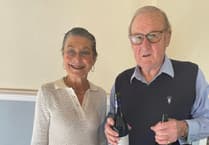The largest audience at an HHH concert for two years was rewarded with an outstanding performance by the Chiaroscuro Quartet at St Christopher’s Church in Haslemere on Saturday, February 26.
Visually they are striking. They stand – except cellist Claire Thirion, who sits on a dais at a level to make eye contact with the group.
Or levels, since very animated first violin Alina Ibragimova stands next to much taller Pablo Hernán Benedí, second violin.
Ibragimova is always in motion: a balletic tussle with her instrument tosses out transparent scraps of tune which hang in the air like soap bubbles. The cellist, and viola player Emilie Hörnlund, look serene by comparison, as if to anchor the group.
The concert opened with three Henry Purcell Fantasias. These are groups of dances, first stately, then lively. Unexpected discords in the harmonies of the slow movements lent a modern feel to these baroque suites.
The group play with historical bows on gut strings, lending warmth and intimacy to their sound, particularly in the fifth of Haydn’s Opus 33 string quartets.
They captured the wit of this piece, which began with good-natured exchanges giving it its nickname, ‘The How do ye do’ quartet, but soon had huge swoops chasing little chirruping phrases. The second movement has a sweet, poignant theme in the first violin, set against a gentle, barcarolle-like accompaniment.
You hope the tune will rock you forever, then Haydn cuts it off with a loud ping. The scherzo scurried to and fro like Tom and Jerry, till the refined drinking song of the finale led to an exuberant close.
The main work was Beethoven’s Quartet Opus 59 No. 3, ‘The Razumovsky’. Its dedicatee, the Count, was a keen amateur violinist who played with the string quartet which premiered it. It starts with a sombre meander through related chords and finally settles on C major. The ensemble earned their name with subtle contrasting of light and darkness.
In the second movement the pizzicato cello punctuates a wistful song, yearning for a lost kingdom where waves break on distant shores.
The third movement is a throwback classical menuetto, but Chiaroscuro played it like the spiky scherzo expected at the time. Beethoven wrongfoots the listener in the finale: what might be a fugue turns into a merry, scampering chase with a fake ending, a real ending and a barnstorming crescendo.
Chiaroscuro lived up to their growing reputation as the gold standard for authentic performance of the late classic and early romantic repertoire.
The picture is by Eva Vermandel.
Martin Robson





Comments
This article has no comments yet. Be the first to leave a comment.